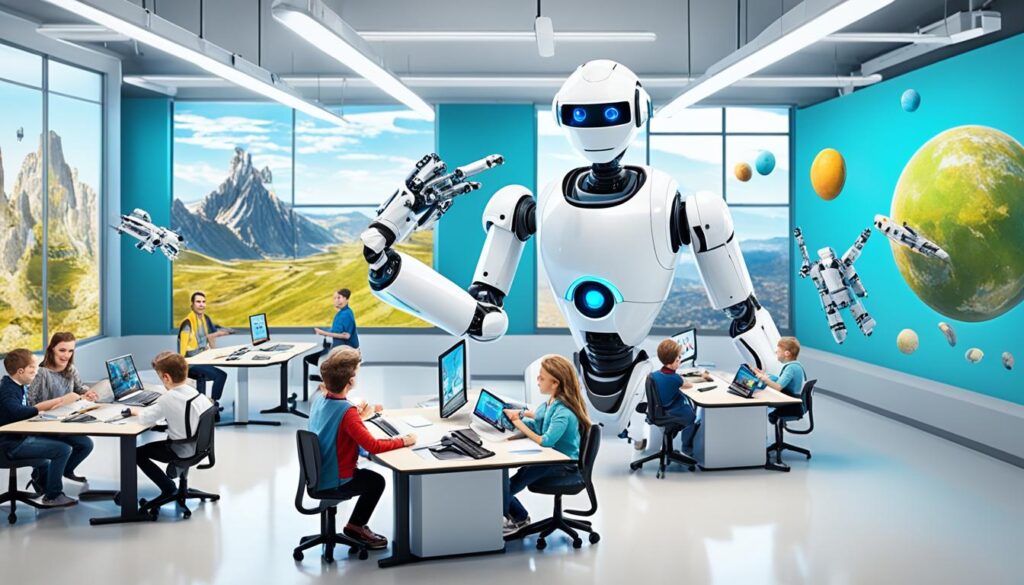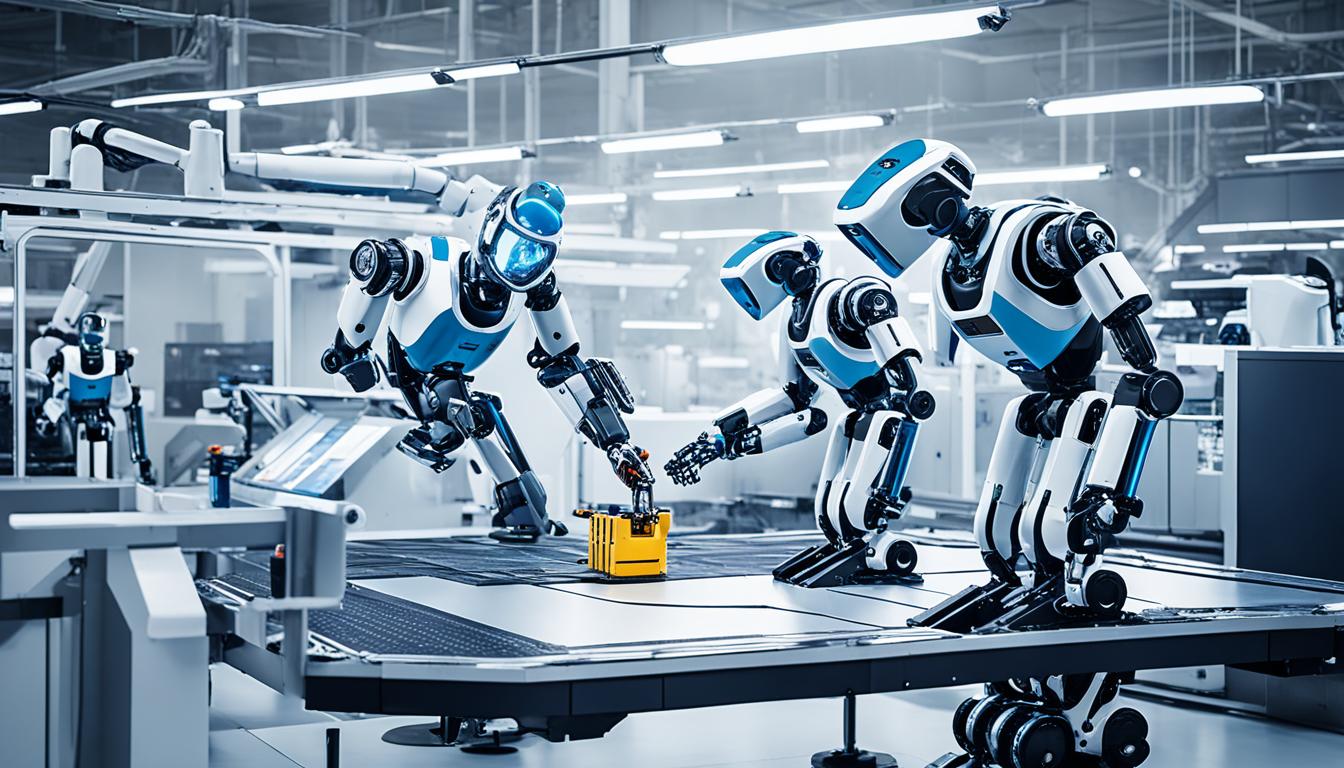As we navigate the ever-evolving landscape of the modern workforce, it’s clear that the rise of artificial intelligence (AI) and automation is poised to reshape the way we work. These technological advancements hold the potential to unlock new levels of efficiency, productivity, and innovation. In this article, we’ll explore the profound impact of AI and automation on the future of work, delving into the benefits, challenges, and emerging trends that will define the workplace of tomorrow.
Key Takeaways
- AI and automation are transforming the way we work, unlocking new levels of efficiency and productivity.
- Rapid technological progress is driving the adoption of AI and automation across industries, with the potential to contribute to economic growth and tackle societal challenges.
- The workforce is undergoing a significant shift, with some occupations declining while new ones emerge, requiring continuous learning and adaptability.
- AI and automation offer both benefits and drawbacks, necessitating a balanced approach to managing their impact on the workforce.
- Navigating the future of work requires innovation, systems-thinking, and the development of safety nets to support workers in the face of technological change.
The Rise of AI and Automation
The world is witnessing a remarkable surge in the development and adoption of AI and automation technologies. Powered by rapid technological progress, these innovations hold immense potential to transform businesses and drive economic growth across the globe.
Rapid Technological Progress
Recent advancements in AI and automation technology have pushed the boundaries of what machines can accomplish. Beyond traditional industrial automation and advanced robots, a new generation of more capable autonomous systems is emerging, driven by improvements in systems, components, and AI algorithms. Breakthroughs in areas like computer vision, natural language processing, and complex game-playing have captured the world’s attention.
Potential to Transform Businesses and Contribute to Economic Growth
The latest generation of AI advancements promises significant value, with the most advanced deep learning techniques potentially accounting for 40% of the value created by all analytics techniques. Furthermore, the deployment of AI and automation technologies could lift global productivity growth to 2% annually over the next decade, with 60% of this increase coming from digital opportunities.
Potential to Tackle Societal Moonshot Challenges
AI applications are being explored in diverse fields, from material science to medical research and climate science. The application of these technologies could help tackle complex societal “moonshot” challenges, such as reducing diagnostic times for intracranial hemorrhaging by up to 96% and more accurately weighting climate models used by the Intergovernmental Panel on Climate Change.
The rapid progress in AI and automation is poised to reshape the future, offering both opportunities and challenges for businesses, economies, and societies worldwide.
How AI and Automation Will Impact the Workforce
As artificial intelligence (AI) and automation continue to advance, the impact on the workforce is becoming increasingly clear. While some jobs may be at risk of displacement, new opportunities are also emerging that could reshape the employment landscape in the years to come.
Automatable Activities and Occupations
Studies suggest that about half of the activities carried out by workers could potentially be automated, including physical tasks in predictable environments, as well as data collection and processing. While only around 5% of occupations can be fully automated with current technologies, up to 30% of the activities in 60% of all jobs could be automated.
Jobs Lost: Some Occupations Will Decline by 2030
It’s estimated that around 15% of the global workforce, or approximately 400 million workers, could be displaced by automation by 2030 under a midpoint adoption scenario. In a faster adoption scenario, this figure could rise to 30%, or 800 million workers. The impact will vary across countries and sectors, with advanced economies potentially seeing 20-25% of their workforce displaced by 2030.
Jobs Gained: New Occupations Will Emerge
In the same period, the demand for new work and the creation of new jobs is expected to range from 21% to 33% of the global workforce, or between 555 million and 890 million new jobs. Emerging economies, like India, are likely to see some of the largest job gains due to their growing working-age populations. Additionally, many new occupations that we cannot currently imagine may also emerge, potentially accounting for as much as 10% of the workforce.
As the impact of AI and automation on the workforce continues to evolve, it will be crucial for individuals, businesses, and policymakers to adapt and prepare for the changes ahead.

AI and Automation: Benefits and Drawbacks
As the integration of artificial intelligence (AI) and automation continues to transform the modern workforce, it’s essential to explore both the potential benefits and drawbacks of these technological advancements. By understanding the nuances of this evolving landscape, we can better navigate the future of work and ensure a seamless human-machine collaboration.
Benefits of AI and Automation in the Workforce
The adoption of AI and automation in the workplace offers a range of compelling benefits. These technologies can drive innovation and spur the creation of new, specialized roles, such as AI system trainers and AI ethics consultants. Moreover, automation can enhance accuracy and safety, reducing the margin of error in hazardous environments and protecting workers from harm.
Drawbacks of AI and Automation in the Workforce
While the advantages of AI and automation are undeniable, these technologies also present some drawbacks that must be addressed. One of the primary concerns is the displacement of workers, especially in sectors relying on routine, manual tasks. Additionally, the rapid technological progress can lead to a skills mismatch, as the demand for skills that complement these new technologies escalates, potentially contributing to increased inequality.
To mitigate the impact on affected workers, strategic responses, including retraining programs and policy interventions, will be crucial in navigating the future of work.
| Benefits of AI and Automation | Drawbacks of AI and Automation |
|---|---|
|
|
“The integration of AI and automation in the workplace presents both exciting opportunities and complex challenges that must be thoughtfully navigated to ensure a thriving, equitable future of work.”
Navigating the Future of Work
As we navigate the rapidly evolving landscape of work, where artificial intelligence (AI) and automation are transforming industries, it’s crucial to embrace a mindset of innovation and continuous learning. By adapting to AI in the workforce and upskilling ourselves, we can not only survive but thrive in this new era.
Innovation and Continuous Learning
Staying ahead of the curve requires a commitment to continuous learning. Partnerships between tech companies and educational institutions are offering innovative training programs, such as coding boot camps and AI literacy courses, to empower workers with the skills needed for emerging roles in the AI-driven workplace. This culture of lifelong learning is essential for adapting to the constant changes brought by technological advancements.
Systems-Thinking Approach to Build Safety Nets
To support workers who may be displaced or adversely affected by the large-scale adoption of automation and AI, a systems-thinking approach is necessary. Employers, educational institutions, and philanthropic organizations must collaborate to create new pathways to success for workers, while simultaneously benefiting from increased automation in the workplace. By building comprehensive workforce safety nets, we can ensure that the transition to an AI-enabled future is smooth and equitable for all.

“Embracing a culture of continuous learning and building collaborative workforce solutions are key to navigating the future of work.”
Adapting Career Navigation for an AI-Driven World
As the world evolves rapidly due to the rise of artificial intelligence (AI) and automation, the need for a dynamic and resilient career navigation system has become increasingly crucial. In this AI-driven era, the traditional approach to career planning may no longer suffice, and individuals must be equipped with the skills and knowledge to navigate the ever-changing job market.
One key aspect of adapting career navigation for the AI era is the need for ongoing research and policy development. Policymakers, educators, and workforce development experts must engage in continuous research to understand the impact of AI and automation on the job market, identify emerging occupations, and develop strategies to ensure equitable career opportunities for all. This research-informed approach can help inform the design of workforce development for AI initiatives, ensuring that the workforce is prepared to thrive in the career navigation in ai era.
Fostering Adaptability and Lifelong Learning
Another crucial element of career navigation in the AI era is the emphasis on adaptability and lifelong learning. As technology rapidly transforms the job market, individuals must be equipped with the ability to learn new skills, reinvent their careers, and embrace the concept of “career agility.” This requires a shift in mindset, where education and training are not seen as one-time events, but rather as an ongoing process of continuous skill development and knowledge acquisition.
| Skill Category | Importance for Career Navigation in the AI Era |
|---|---|
| Critical Thinking and Problem-Solving | The ability to analyze complex problems, think creatively, and devise innovative solutions will be increasingly valuable as AI systems automate many routine tasks. |
| Adaptability and Lifelong Learning | The capacity to learn new skills, pivot between careers, and continuously upgrade one’s knowledge will be essential for navigating the ever-changing job market. |
| Emotional Intelligence and Interpersonal Skills | As AI systems handle more technical and analytical tasks, the human skills of empathy, communication, and collaboration will become increasingly important in the workplace. |
By embracing the principles of adaptability and lifelong learning, individuals can position themselves for success in the career navigation in ai era, ensuring they are prepared to navigate the challenges and capitalize on the opportunities presented by the transformative power of AI and automation.
“The future of work is a moving target, and we must be prepared to continuously adapt and evolve our career navigation strategies to keep pace with the rapid changes driven by AI and automation.”
Conclusion
As we navigate the transformative landscape of AI and automation, it’s clear that the future of work holds immense promise. By harnessing the power of these technologies, we can unlock new opportunities for growth, innovation, and societal progress. However, to fully realize this potential, we must approach the challenge with a collaborative spirit and visionary leadership.
The key lies in championing lifelong learning and creating robust systems of support. By empowering individuals to continuously adapt and acquire new skills, we can ensure that the workforce remains agile and resilient in the face of the future of work with ai. Additionally, by building comprehensive safety nets and promoting ai and workforce equity, we can safeguard the dignity and well-being of all workers, regardless of their occupation or background.
Ultimately, the transforming work with automation presents us with an opportunity to redefine the future of work in a manner that amplifies human potential and fosters a more inclusive, prosperous society. Through a collective effort and a steadfast commitment to adaptability, we can harness the power of AI and automation to create a brighter, more equitable tomorrow for all.
Source Links
- AI, automation, and the future of work: Ten things to solve for – https://www.mckinsey.com/featured-insights/future-of-work/ai-automation-and-the-future-of-work-ten-things-to-solve-for
- AI and the Future of Work | National Fund for Workforce Solutions – https://nationalfund.org/ai-and-the-future-of-work/
- The future of work: How will AI and automation affect work? – https://www.uc.edu/news/articles/2023/05/the-future-of-work–how-will-ai-and-automation-affect-work.html
